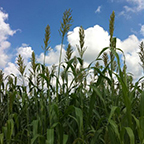Sweet sorghum productivity for biofuels under increased soil salinity and reduced irrigation
Abstract
 Sweet sorghum (Sorghum bicolor (L.) Moench.) is a drought-tolerant crop with high resistance to saline-alkaline soils, and sweet sorghum may serve as an alternative summer crop for biofuel production in areas where irrigation water is limited. A two-year study was conducted in Northern Greece to assess the productivity (biomass, juice, total sugar and theoretical ethanol yields) of four sweet sorghum cultivars (Sugar graze, M-81E, Urja and Topper-76-6), one grain sorghum cultivar (KN-300) and one grass sorghum cultivar (Susu) grown in intermediate (3.2 dS m(-1)) or in high (6.9 dS m(-1)) soil salinity with either low (120 mm) or intermediate (210 mm) irrigation water supply (supplemented with 142-261 mm of rainfall during growth). The soil salinity and irrigation water supply effects on the sorghum chlorophyll content index, photosystem II quantum yield, stomatal conductance and leaf K/Na ratio were also determined. The sorghum emergence averaged 75,083 plants ha(-1) and 59.917 plants ha(-1) in a soil salinity of 3.2 dS m(-1) and 6.9 dS m(-1), respectively. The most affected cultivar, as averaged across the two soil salinity levels, was the Susu grass sorghum emerging at 53,250 plants ha(-1), followed by the Topper-76-6 sweet sorghum emerging at 61,250 plants ha(-1). The leaf K/Na ratio decreased with decreasing irrigation water supply, in most cases, but it was not significantly affected by soil salinity. The dry biomass, juice and total sugar yields of sorghum that received 210 mm of irrigation water was 49-88% greater than the yields of sorghum that received the 120 mm of irrigation water. Sorghum plants grown in a soil salinity of 3.2 dS m(-1) produced 42-58% greater dry biomass, juice and total sugar yields than the yields of sorghum plants grown in a soil salinity of 6.9 dS m(-1). The greatest theoretical ethanol yield was produced by sweet sorghum plants grown in a soil salinity of 3.2 dS m(-1) with 210 mm of irrigation water (6130 L ha(-1), as averaged across cultivar), and the Urja and Sugar graze cultivars produced the most ethanol (7620 L ha(-1) and 6528 L ha(-1), respectively). Conclusively, sweet sorghum provided sufficient juice, total sugar and ethanol yields in fields with a soil salinity of 3.2 dS m(-1), even if the plants received 50-75% of the irrigation water typically applied to sorghum. (C) 2010 Elsevier B.V. All rights reserved.
Sweet sorghum (Sorghum bicolor (L.) Moench.) is a drought-tolerant crop with high resistance to saline-alkaline soils, and sweet sorghum may serve as an alternative summer crop for biofuel production in areas where irrigation water is limited. A two-year study was conducted in Northern Greece to assess the productivity (biomass, juice, total sugar and theoretical ethanol yields) of four sweet sorghum cultivars (Sugar graze, M-81E, Urja and Topper-76-6), one grain sorghum cultivar (KN-300) and one grass sorghum cultivar (Susu) grown in intermediate (3.2 dS m(-1)) or in high (6.9 dS m(-1)) soil salinity with either low (120 mm) or intermediate (210 mm) irrigation water supply (supplemented with 142-261 mm of rainfall during growth). The soil salinity and irrigation water supply effects on the sorghum chlorophyll content index, photosystem II quantum yield, stomatal conductance and leaf K/Na ratio were also determined. The sorghum emergence averaged 75,083 plants ha(-1) and 59.917 plants ha(-1) in a soil salinity of 3.2 dS m(-1) and 6.9 dS m(-1), respectively. The most affected cultivar, as averaged across the two soil salinity levels, was the Susu grass sorghum emerging at 53,250 plants ha(-1), followed by the Topper-76-6 sweet sorghum emerging at 61,250 plants ha(-1). The leaf K/Na ratio decreased with decreasing irrigation water supply, in most cases, but it was not significantly affected by soil salinity. The dry biomass, juice and total sugar yields of sorghum that received 210 mm of irrigation water was 49-88% greater than the yields of sorghum that received the 120 mm of irrigation water. Sorghum plants grown in a soil salinity of 3.2 dS m(-1) produced 42-58% greater dry biomass, juice and total sugar yields than the yields of sorghum plants grown in a soil salinity of 6.9 dS m(-1). The greatest theoretical ethanol yield was produced by sweet sorghum plants grown in a soil salinity of 3.2 dS m(-1) with 210 mm of irrigation water (6130 L ha(-1), as averaged across cultivar), and the Urja and Sugar graze cultivars produced the most ethanol (7620 L ha(-1) and 6528 L ha(-1), respectively). Conclusively, sweet sorghum provided sufficient juice, total sugar and ethanol yields in fields with a soil salinity of 3.2 dS m(-1), even if the plants received 50-75% of the irrigation water typically applied to sorghum. (C) 2010 Elsevier B.V. All rights reserved.
